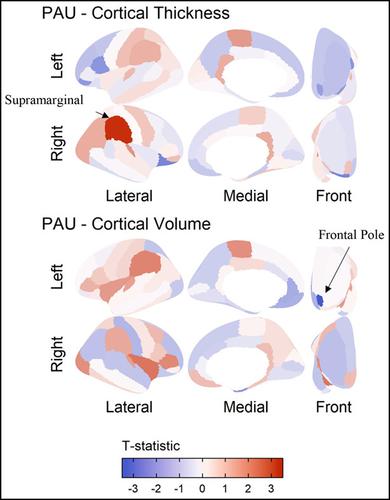当前位置:
X-MOL 学术
›
Genes Brain Behav.
›
论文详情
Our official English website, www.x-mol.net, welcomes your
feedback! (Note: you will need to create a separate account there.)
Polygenic risk scores for alcohol involvement relate to brain structure in substance-naïve children: Results from the ABCD study
Genes, Brain and Behavior ( IF 2.4 ) Pub Date : 2021-06-06 , DOI: 10.1111/gbb.12756 Alexander S Hatoum 1 , Emma C Johnson 1 , David A A Baranger 2 , Sarah E Paul 3 , Arpana Agrawal 1 , Ryan Bogdan 3
Genes, Brain and Behavior ( IF 2.4 ) Pub Date : 2021-06-06 , DOI: 10.1111/gbb.12756 Alexander S Hatoum 1 , Emma C Johnson 1 , David A A Baranger 2 , Sarah E Paul 3 , Arpana Agrawal 1 , Ryan Bogdan 3
Affiliation

|
Brain imaging-derived structural correlates of alcohol involvement have largely been speculated to arise as a consequence of alcohol exposure. However, they may also reflect predispositional risk. In substance naïve children of European ancestry who completed the baseline session of the Adolescent Brain Cognitive Development (ABCD) Study (n = 3013), mixed-effects models estimated whether polygenic risk scores (PRS) for problematic alcohol use (PAU-PRS) and drinks per week (DPW-PRS) are associated with magnetic resonance imaging-derived brain structure phenotypes (i.e., total and regional: cortical thickness, surface area and volume; subcortical volume; white matter volume, fractional anisotropy, mean diffusivity). Follow-up analyses evaluated whether any identified regions were also associated with polygenic risk among substance naïve children of African ancestry (n = 898). After adjustment for multiple testing correction, polygenic risk for PAU was associated with lower volume of the left frontal pole and greater cortical thickness of the right supramarginal gyrus (|βs| > 0.009; ps < 0.001; psfdr < 0.046; r2s < 0.004). PAU PRS and DPW PRS showed nominally significant associations with a host of other regional brain structure phenotypes (e.g., insula surface area and volume). None of these regions showed any, even nominal association among children of African ancestry. Genomic liability to alcohol involvement may manifest as variability in brain structure during middle childhood prior to alcohol use initiation. Broadly, alcohol-related variability in brain morphometry may partially reflect predisposing genomic influence. Larger discovery genome-wide association studies and target samples of diverse ancestries are needed to determine whether observed associations may generalize across ancestral origins.
中文翻译:

酒精参与的多基因风险评分与未接触物质的儿童的大脑结构有关:ABCD 研究的结果
大脑成像衍生的酒精参与的结构相关性在很大程度上被推测是由于酒精暴露而产生的。然而,它们也可能反映了易感风险。在完成青少年大脑认知发展 (ABCD) 研究 (n = 3013) 基线会议的欧洲血统的物质天真儿童中,混合效应模型估计了问题性饮酒的多基因风险评分 (PRS) (PAU-PRS) 和每周饮酒量(DPW-PRS)与磁共振成像衍生的大脑结构表型(即总体和局部:皮质厚度、表面积和体积;皮质下体积;白质体积、各向异性分数、平均扩散率)相关。后续分析评估了任何确定的区域是否也与非洲血统的未接触过物质的儿童的多基因风险相关(n = 898)。经过多重测试校正后,PAU 的多基因风险与左额极体积较小和右侧边缘上回皮质厚度较大相关(|βs| > 0.009;ps < 0.001;ps fdr < 0.046;r 2 s < 0.004)。 PAU PRS 和 DPW PRS 与许多其他区域脑结构表型(例如岛叶表面积和体积)名义上显示出显着相关性。这些地区都没有显示出非洲血统儿童之间存在任何甚至名义上的联系。酒精参与的基因组倾向可能表现为儿童中期开始饮酒之前大脑结构的变异。从广义上讲,与酒精相关的大脑形态测量变异可能部分反映了基因组的易感性影响。 需要更大规模的全基因组关联研究和不同祖先的目标样本来确定观察到的关联是否可以推广到各个祖先的起源。
更新日期:2021-07-07
中文翻译:

酒精参与的多基因风险评分与未接触物质的儿童的大脑结构有关:ABCD 研究的结果
大脑成像衍生的酒精参与的结构相关性在很大程度上被推测是由于酒精暴露而产生的。然而,它们也可能反映了易感风险。在完成青少年大脑认知发展 (ABCD) 研究 (n = 3013) 基线会议的欧洲血统的物质天真儿童中,混合效应模型估计了问题性饮酒的多基因风险评分 (PRS) (PAU-PRS) 和每周饮酒量(DPW-PRS)与磁共振成像衍生的大脑结构表型(即总体和局部:皮质厚度、表面积和体积;皮质下体积;白质体积、各向异性分数、平均扩散率)相关。后续分析评估了任何确定的区域是否也与非洲血统的未接触过物质的儿童的多基因风险相关(n = 898)。经过多重测试校正后,PAU 的多基因风险与左额极体积较小和右侧边缘上回皮质厚度较大相关(|βs| > 0.009;ps < 0.001;ps fdr < 0.046;r 2 s < 0.004)。 PAU PRS 和 DPW PRS 与许多其他区域脑结构表型(例如岛叶表面积和体积)名义上显示出显着相关性。这些地区都没有显示出非洲血统儿童之间存在任何甚至名义上的联系。酒精参与的基因组倾向可能表现为儿童中期开始饮酒之前大脑结构的变异。从广义上讲,与酒精相关的大脑形态测量变异可能部分反映了基因组的易感性影响。 需要更大规模的全基因组关联研究和不同祖先的目标样本来确定观察到的关联是否可以推广到各个祖先的起源。











































 京公网安备 11010802027423号
京公网安备 11010802027423号